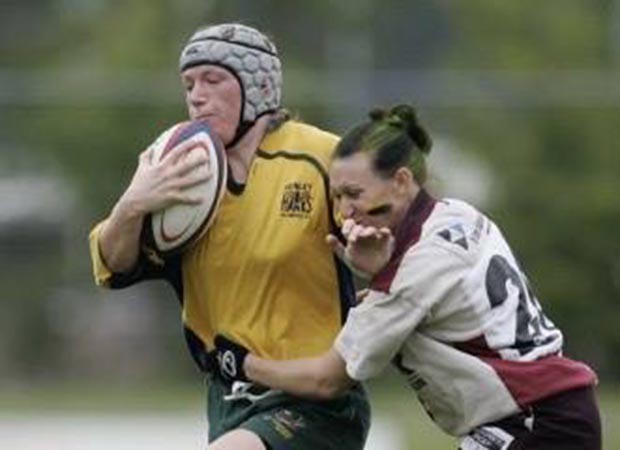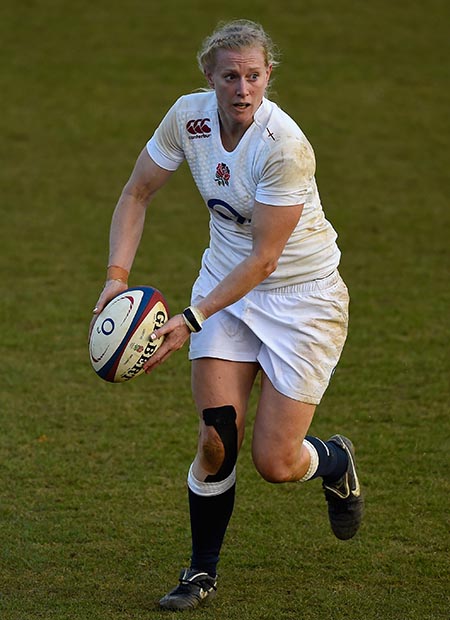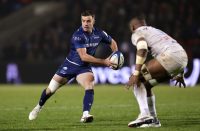 Rochelle Clark and Tamara Taylor are seasoned world champions who will play a crucial role in the Red Roses‘ bid to retain their title at the 2017 Women’s Rugby World Cup in Ireland this month. However, their story has a wider resonance because it confronts the RFU with unassailable reasons why it should make the fifteen-a-side version of Women’s rugby its priority.
Rochelle Clark and Tamara Taylor are seasoned world champions who will play a crucial role in the Red Roses‘ bid to retain their title at the 2017 Women’s Rugby World Cup in Ireland this month. However, their story has a wider resonance because it confronts the RFU with unassailable reasons why it should make the fifteen-a-side version of Women’s rugby its priority.
It sends the clearest message possible why English Rugby Union‘s governing body should not be dithering at a crossroads in terms of evaluating the merits of fifteens against sevens, because Clark and Taylor are a driving force in an England fifteens side that has given the women’s game the highest profile it has had.
Loose-head Clark, 36, and lock Taylor, 35, are not just the senior hands in this campaign. They are proof that the women’s game – like its male counterpart – should cherish its mission statement as one for all shapes and sizes, with Taylor tall, blonde and having filled out after being lanky, and the shorter, stockier Clark having shed loads of weight and replaced it with muscle.
What makes them special is that they have maximised on their physical capabilities to not only win over 100 caps for their country, but that their story – which began when they joined Henley Hawks in their teens – is the stuff that will inspire young girls to believe that they, too, can fulfil their dreams of being top tier sportswomen. The only proviso is that, like Clark and Taylor, they have to be prepared to dig in and give it everything they’ve got.
What is also remarkable is that they are part of a quartet of former Henley girls – the other two are full-back Danielle Waterman and centre Rachel Burford – who started in England’s 2014 World Cup final victory over Canada, and are back together again for their fourth World Cup tournament.
Although Waterman and Burford were at the club for shorter stints of two seasons, it illustrates why Henley can lay claim to be one of the best rugby nurseries in the country despite being outside the new Tyrrell’s-sponsored Women’s Premiership.
Clark has a record-breaking 125 England caps, the latest of them earned when she came off the bench in Tuesday’s 56-5 victory against Spain. Taylor is the second most capped player with 105, and is expected to be part of England’s starting second row combination as the tournament intensifies with the Red Roses chasing a second consecutive world title.
However, both of these England Women landmark stars look back with great affection at the grounding they got at Henley during a period in which the Hawks Women won five consecutive promotions between 1997 and 2002 under the tutelage of coach Jerry Edwards. He stepped down after winning them a place in the Women’s Premiership to raise a family, and during the promotion run he worked alongside the late Peter Allen, a Henley stalwart who was invited to be president and team manager.
Edwards, a former Hawks first-team flanker, says that both Clark and Taylor made an immediate impression on him. “Rochelle joined us after playing for Beaconsfield. She was a bit of a dump-truck when she was a kid of 16, and liked a smoke and a drink. She was scrummaging against women and demolishing them for fun, although we had to take her off after 60 minutes because she didn’t have the fitness.”
Edwards says that it was Allen who gave the young Rochelle some priceless advice. “I remember him saying to her, ‘one day if you get off the tabs and stop drinking you could play for England’. And she has proved him right.”
He adds: “One time me and another Henley coach holding the tackle bags as Rochelle, who was probably 17 stone (100kg) then, crashed into them. We both agreed, ‘She can move, and she’s got some power’. Shelley was aggressive and had a chip on her shoulder. She had everything. She scored a hat-trick of tries in one game in the promotion run – she was just brutal when she got close to the line.”
Rob Heginbotham, former first team prop, captain and Henley director of rugby, recalls Edwards asking him to help Clark with her technique. “I decided to pack down against her in the second session, and was obviously mindful that this was a young girl so I should take it easy. Wrong decision – 17 stone smashed into me and I was completely unprepared for the power she transmitted. It was clear that she had something completely different to offer, and that with the right focus she could go right to the top, and the rest is history.”
 Edwards says that Clark’s inexorable advance up the rankings was also reflected in the names she went by. “When she was with us it was always ‘Shelley’ but then later, after she’d changed body shape completely, when she came back to the club she had been reinvented as ‘Rocky’. I didn’t recognise her at first.”
Edwards says that Clark’s inexorable advance up the rankings was also reflected in the names she went by. “When she was with us it was always ‘Shelley’ but then later, after she’d changed body shape completely, when she came back to the club she had been reinvented as ‘Rocky’. I didn’t recognise her at first.”
If Clark was larger than life, Taylor was by her own admission “a shy skinny thing when I joined Henley”. Edwards agrees: “Tam was more of a dark horse when she arrived – very quiet, wouldn’t say boo to a goose. She’s the real surprise because it takes a lot to play that long in the engine room at that level. She is very determined and although she’s more of a grafter than a natural athlete, she just got better and stronger every season.”
Taylor’s brother was with the Colts at Henley, and Edwards says she came along with her dad to watch him play – and then started watching the women play. “She trained with us for a whole season religiously at 15 because she couldn’t play until she was 16, and the next season we put her on the wing. She got the run-around because she wasn’t quick enough, but then we put her at lock and we knew straight away that she had found her home.”
Edwards’ wife Karen, who also played in the same Henley team, remembers another incident. “Tam was only 17, and had just passed her driving test when she hit a deer on the way to training, and unfortunately killed it. Although the car was drivable there was a dent in it, and then she had Jerry to contend with…
Edwards explains: “We gave her a nickname. ‘Bambi Murderer’, which then became Bambi. You know what it’s like in rugby – never tell your teammates anything.”
The incident is imprinted in Taylor’s memory. “I was seriously traumatised, but when I was called Bambi I realised there wasn’t going to be too much sympathy. I look back on the Hawks very fondly. It was my first club, and when I joined at 17 the girls were amazing. They were a very good mix of young girls and those with more experience, and the coaches were fantastic. It was perfect for me at the time.”
Clark is just as effusive. “It’s when the journey began and the dream first took shape. I was a big girl then, but I learned a lot from coaches like Jerry Edwards, and it was a really good time of my life. I left the club when I went to university and played for Clifton, and then I moved from Blaydon to Worcester.”
She adds: “When I first got into rugby I was very much a social player, but basically at Henley I went from being a kid to an adult. When I got to university and got my first England cap (in 2003) I realised I had to work hard whether it was in the gym or getting the right nutrition. But the biggest thing for any young player is that you still have to enjoy your rugby. You have to make sacrifices, but you get satisfaction in different ways.”
Edwards admiration for what she has achieved is transparent: “Rugby is in her blood, and I think she’ll go into coaching, managing or promoting the game. It’s her whole life, and her enthusiasm is infectious. She’s very competitive on the pitch and just wants to win, but off the pitch she’s one of the girls.”
Clark, who is now a trimmer 13st 5lbs (86kg), says that the England pro contracts awarded in 2014 boosted the strength and conditioning work, and paid dividends for the entire squad.
 “It’s been a really tough regime, especially since January. I have never done the amount of strength and conditioning sessions we have this time. Stu Pickering turned our world upside down before the 2014 World Cup, and we have built on that base since then.”
“It’s been a really tough regime, especially since January. I have never done the amount of strength and conditioning sessions we have this time. Stu Pickering turned our world upside down before the 2014 World Cup, and we have built on that base since then.”
Taylor, who now plays for Darlington Mowden Park, reinforces the benefits. “This year England having strength and conditioning coaches as well as backroom staff makes a huge difference. It’s off the scale, with more funding and more time training together, and programs which are more individual. If you look at the squad in physical terms between 2005 and now there is no question that we have changed body shape. In the past I did all the sessions we do now and then went to work as a teacher/coach, whereas now I have a chance to rest and recover.”
Both are wary of overconfidence despite England going into the 2017 tournament as strong favourites, having gone top of the world rankings after beating New Zealand, Canada and Australia in the space of eight days in June.
Taylor is mindful in particular that England have beaten New Zealand before going into World Cups but then had the tables turned on them. “It’s worth remembering that we beat them in 2009 but then the next time we met in the 2010 World Cup final we lost. This World Cup is wide open, with five or six sides capable of winning on any given day.”
However, Edwards belief in the girls he coached from their teens to early adulthood is unwavering.
“It’s amazing how it all turns around, and you find two England forwards of that stature. I just gave them the basics over the course of two training sessions each week and a match. Then we got on a roll with these young forwards destroying everyone…”
He hopes there will be more of the same with the two Hawks having matured into two of the most formidable forwards in the women’s game, and Clark is of like mind. “Our resolve to retain the World Cup is massive. There are still some of us left from 2014, but there are also a lot of newbies in the squad who want to win the trophy for the first time – and me, I want to be a double World Cup winner.”
Whether or not they achieve that double, when it comes to being positive sporting role models for the Women’s fifteens game Rochelle Clark and Tamara Taylor are already winners.























